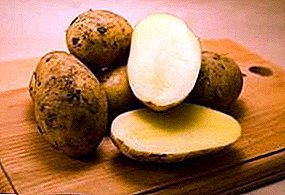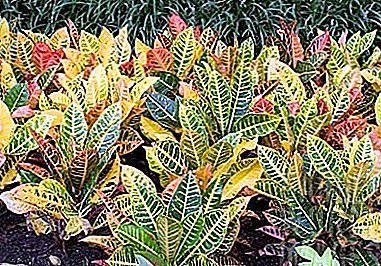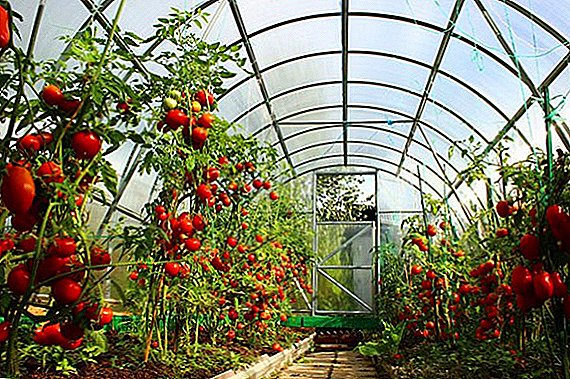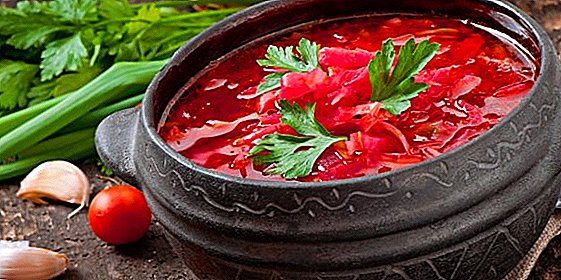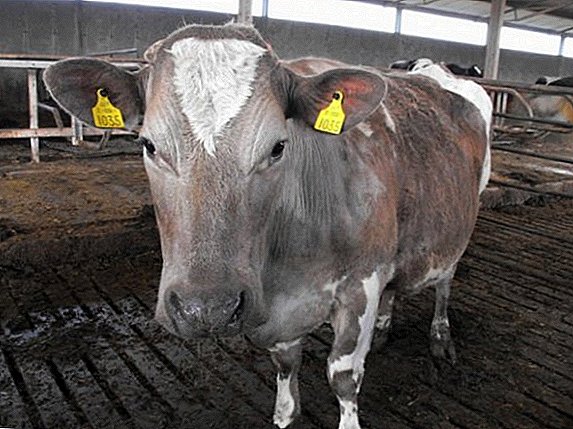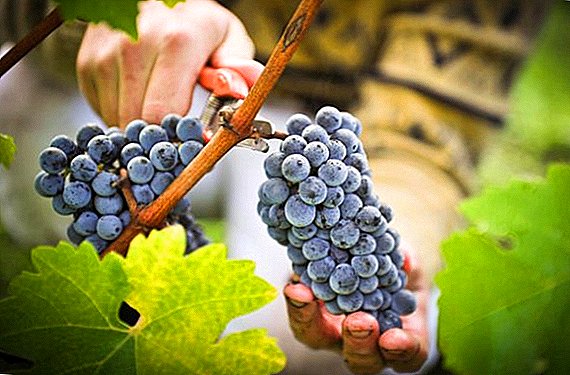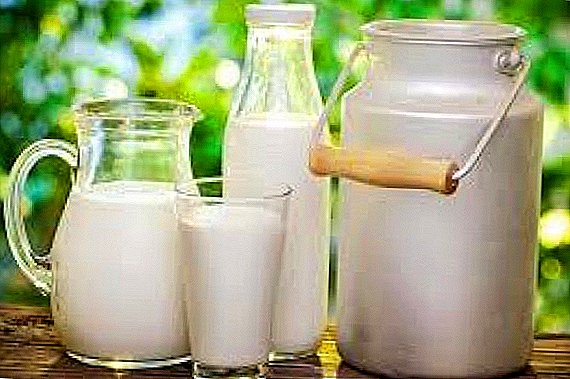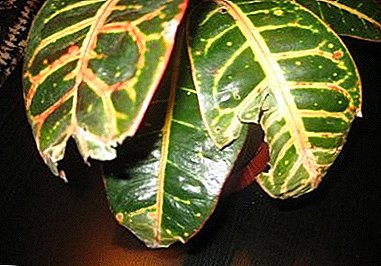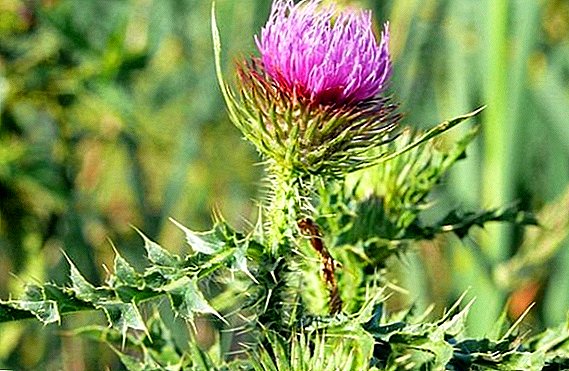 Tatarnik is often confused with burdock or thistle: the external similarity of the inflorescences is actually observed, but otherwise it is an absolute difference. On the medicinal and other beneficial properties of thistle prickly talk in this article.
Tatarnik is often confused with burdock or thistle: the external similarity of the inflorescences is actually observed, but otherwise it is an absolute difference. On the medicinal and other beneficial properties of thistle prickly talk in this article.
Botanical description
It is a grassy biennial that grows up to 2 m tall. The root system has a central rod in the shape of an elongated cone and thin side branches. Straight thick and ribbed stalk branches in the upper part, it is covered with small prickly pile and large thorns with a wide base.

The leaves are spiky on the edge, gray-green, the bottom are collected in the rosette, large, up to 30 cm in length. At the top, the leaf plates are narrower and shorter. Along the leaf plates is a lighter band in the center. The green parts of the bush are covered with arachnoid bloom, which serves as protection against sunburn.
Did you know? There is an interesting bike about the plant: it is known that Alexey II’s son Alexey was sick with hemophilia, in which there is no special protein in the body that is responsible for blood clotting. In search of drugs that support the prince's organism, a doctor, a Tatar, was brought to the court. He helped stabilize Alexei’s condition using an infusion of prickly grass brought with him. Since then she is called prickly
The receptacle is tall, green-gray in color, a basket of tiny leaves arranged in a tiled pattern, dotted with spiky cilia. Inflorescence in the form of a fluffy tuft consists of a set of tubular petals, lilac-lilac color. Flowering period - from July to August inclusive. Fading, forms a box with seeds.

Distribution and habitat
The plant is well propagated by self-sowing. and is not afraid of low or high temperatures, so you can meet it in the north of Africa, and in Siberia. The steppes, meadows, fields, open spaces of the sun, and the banks of reservoirs are a natural habitat for thorny shrubs.
Chemical composition
The seeds of the plant are rich in fatty oil, in addition to it, the remaining parts contain the following elements:

- starch;
- protein;
- vitamin C;
- coumarins;
- inulin;
- saponins;
- flavonoids;
- alkaloids.
Beneficial features
The plant has the following healing properties:

- healing;
- antiseptic;
- diuretic;
- hemostatic;
- cleansing;
- expectorant;
- astringent;
- tonic;
- sedative;
- immunomoduliruyuschim.
Ascorbic acid supports immunity and helps fight the common cold. The substance creates an acidic environment in the body, which is detrimental to viruses.
Also, immunity is positively affected: safflower, horseradish, garlic, wild garlic, fir, black walnut, aloe, almonds, viburnum, dogwood, Chinese magnolia vine, mint, basil, lemon balm.
Coumarins have a blood thinning effect, helping in the formation of blood clots, and their antifungal properties are also known.
Saponins have sputum-thinning action in the bronchi and lungs, they also have a regenerating effect on ulcers of the mucous membranes. They also have a mild laxative effect on the body.

Flavonoids help reduce swelling, strengthen the walls of blood vessels, make them more elastic. These substances support the immune system, slow down the aging process of cells, normalize hormones.
Did you know? The plant is used for magical purposes in the rites of the expulsion of dark forces from abandoned premises, fumigated by burned stalks of patients with damage.
Plant application
Despite the poorly studied chemical composition of the plant, some of its properties were noticed by ancient physicians and herbalists. Today prickly raw materials are used in collections for medical and cosmetic purposes.
In medicine
All parts of the plant are used in medicine:

- for the treatment of purulent wounds, skin ulcers and dermatitis, with scabies;
- to normalize low blood pressure to relieve rapid heartbeat, strengthen blood vessels;
- for the treatment of urinary tract infections, with pyelonephritis;
- with gastritis and diseases of the pancreas;
- for cleansing the blood during food and chemical poisoning;
- to relieve a painful symptom of gout, arthritis, rheumatism;
- with anemia and avitaminosis;
- for insomnia and neurosis;
- with colds, throat and lung diseases.
To cope with insomnia will help you catnip, verbena officinalis, white mulberry, goji berries, elder, sweet clover, St. John's wort, sweet potato.
For cosmetic purposes, oil is used as the basis for homemade cosmetics, and a component for therapeutic hair and skin masks for cellulite wraps. Flowers and foliage are used to treat acne, purulent acne and blackheads.
Important! The prickly doctor has some sedative effect, therefore it is necessary to take drugs based on it after consulting with a doctor.
In cooking
Ascorbic acid gives sour folia therefore, supporters of a healthy diet use them in salads, fillings for baking, soups and stews, okroshka. Due to the presence of protein dishes are quite satisfying. Starchy roots can also be used by grinding into flour or adding them to dishes, like, say, celery and parsley roots.

In beekeeping
There is no exact data on the productivity of the honeycomb as a honey plant. But beekeepers noted that working bees spend a lot of time on flowers, bringing nectar and pollen to hives. It is known that tatarnik is included in the beekeeping feed base of Uzbekistan.

Contraindications
Among the contraindications to the use of drugs from the tatarnik are the following states:

- arrhythmia;
- tachycardia;
- pregnancy and lactation;
- hypertension;
- age up to 8 years.
Important! Allergy sufferers should first conduct a tolerance test on the plant.
Harvesting and storage of raw materials
Preparation of raw materials involved in late autumn, armed with a change of clothing and gloves made of thick fabric. Such precautions are needed to protect against thorns and juice secreted from the stems. Cut annual shoots, foliage, flowers (during flowering) and dig out the rhizome.

All parts are prepared separately: spikes are removed from above-ground parts, the raw materials are dried in the shade, in a ventilated room, spread out on a piece of thick fabric or paper. Rhizome pre-cleaned, washed and crushed.
Other plants also have medicinal properties, such as lungwort, laconosa, savory, white silverweed, marsh wild rosemary, peppermint, anise, and cholstyanka.
Store raw materials in bags of natural fabric for about two years.

More and more people are turning for help not to official medicine, but to herbalists and medicine men. Perhaps this is correct, because it is enough to read the story of our ancestors, who lived to old age in complete health and reason without the "chemistry" on which the pharmacopoeia is based. And yet, it’s also impossible to refuse doctors, especially to self-medicate, it’s best to find a middle ground.


